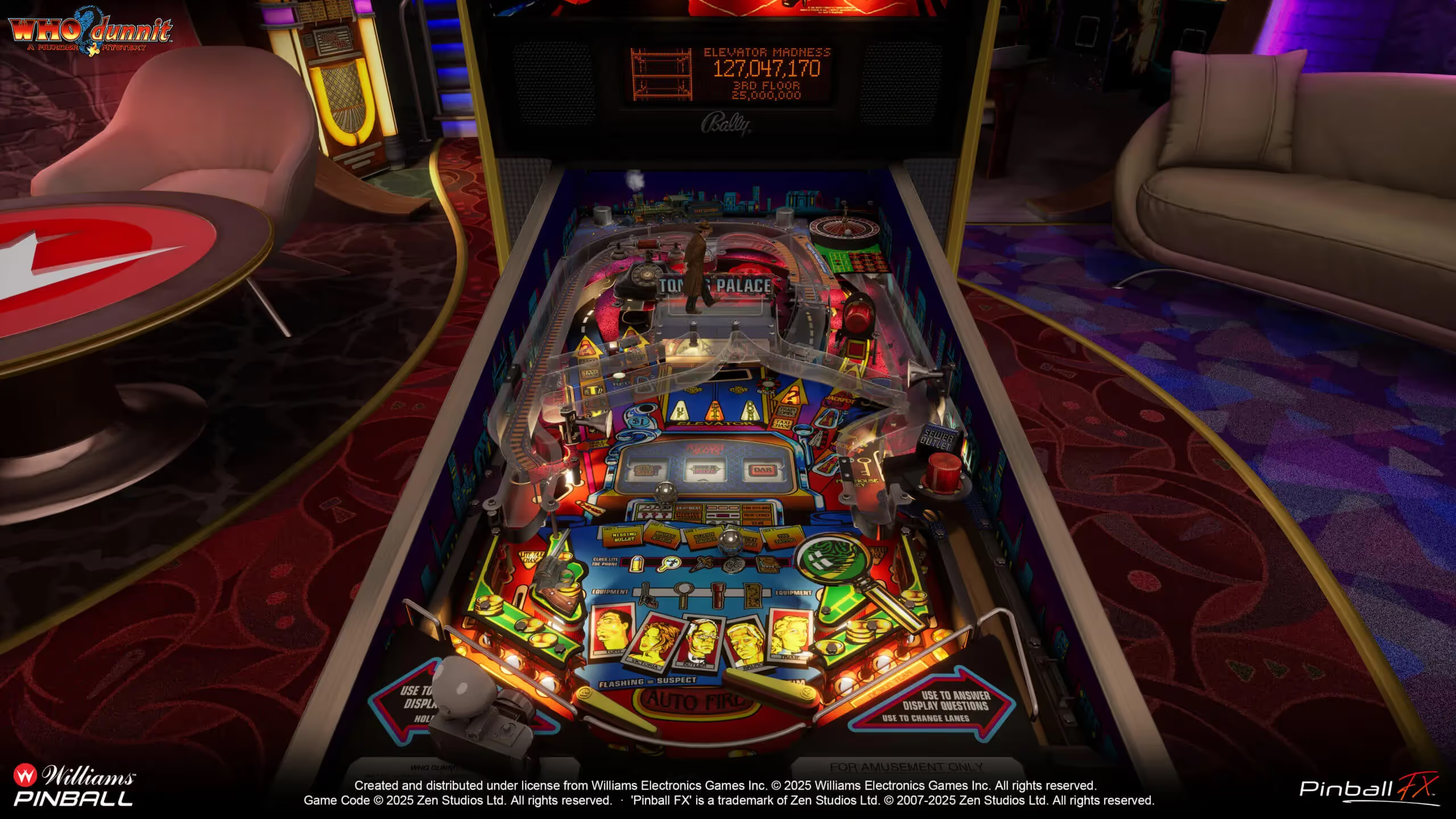Review: Williams Pinball Volume 9 on Pinball FX

Zen has continued to make good on their promise of more Williams pinball recreations with a new pack featuring 2 mid-80s alphanumeric tables and one mid-90s DMD release. All three tables are on the shallow side when it comes to rule depth and scoring, but 2 of the 3 are some of the most iconic 80s pinball machines ever, and the other one is a table I have quite the soft spot for even though I don’t “objectively” think it’s a good table. No glitches to report with this pack either: all three tables play authentically as possible though I will take time to bring up some of their difficult aspects.
Williams Pinball Volume 9 is available for all Pinball FX platforms as of publishing. Though it isn’t my favorite pack they’ve released, I found it to be about as good overall as volume 8 with three tables all consistent in quality.
Pin*Bot

Hey, a table that I already did a tutorial for! Pin*Bot is one of the quintessential pinball machines of the 1980s. Though the design was Barry Oursler’s baby, this table is commonly regarded as the one that put the madcap mind of Python Anghelo on the map; his artwork and concepts would become synonymous with Williams & Bally tables for a majority of the late 80s and some of the early 90s. I don’t think that the impact of this one was as big as High Speed which released around the same time and was similarly influential, but I prefer the artwork and vibes of Pin*Bot. Just a matter of personal preference.
Though the story of Pin*Bot isn’t the focal point, the artwork helps illustrate it: Pin*Bot is a robot that was sent by the US space force to travel through the solar system and reach the sun. On his intergalactic travels, he encounters a space nymph who assists him, represented by the second “pachinko” playfield above the bumpers. The robot also has pinballs for eyes and a visor blocking access to them unless the player can knock the barrier down with enough shots. Multiball is the cornerstone feature of the game, and a well-timed visor shot can light the locks in one shot, but big scores can also come from the vortex skill shot – potentially worth up to a million – and the left saucer which scores up to 75k and eventually lights the extra ball.

The Pinball FX recreation is mostly accurate to the real table but has two slight flaws: I feel that the feed coming out of the bumper area is way too safe on this version compared to that of the real table, and the feed from the left saucer could use a bit more inconsistency. Regarding the bumpers, the gate near the plunger is meant to send the ball a bit out of control and can potentially pick up more bumpers on its own; and regarding the left saucer, this might be a blessing in disguise as on some copies, it can release the ball dangerously close to straight down the middle. However, other difficult aspects of the table are properly captured: the visor is just as dangerous to shoot for here as it is on the real thing, and the Pin*Bot eye saucers are tougher to shoot than they look.
Pin*Bot is one of the earliest “vibe tables” I can think of: you play it with the audio cranked up and you feel like you’re in a completely different setting thanks to the sound design by Chris Granner & Bill Parod, and the colorful art only enhances the unique atmosphere of this table. This isn’t one I come back to a lot due to the repetitiveness of lighting and playing multiball, and I dislike that the solar value resets so quickly; but it’s still a fun table whether you play it in real life or on this recreation.
Taxi

Getting my thoughts out upfront, I like Taxi a lot. It’s absolutely a time capsule of the late 80s, but plenty of pinball machines reflect the eras that they were made in and this one is no exception. Like Pin*Bot, Python Anghelo had a massive influence on the direction this table went in; but the playfield was designed by Mark Ritchie and has some of his design signatures including the criss-crossing ramps common to his games.
Taxi sums up its gameplay in one word: you’re a taxi driver trying to pick up five customers represented by different shots around the playfield. Once all five are picked up, the jackpot is lit and scoring it will reset the process but light only one passenger at a time. The player can access the express lane in a 2-ball multiball or go for the airport million by alternating shots between the two ramps. While the premise is straightforward, the passengers you pick up certainly aren’t: Gorbie and Dracula are some of the ones who need rides, and even our good friend Pin*Bot has somehow been left stranded. Honestly though, given the difficulty of completing those right drop targets, you must wonder how good of a customer Pin*Bot really is. I bet he doesn’t even leave tips – sorry, got off track there.
This table plays completely accurately to the real thing with one exception, and this exception I think was always going to be difficult to emulate: I cannot find the timing on scoring the “25k + spot passenger” from the spinout skill shot. I’ve been able to score the 75k and 100k perfectly fine, but every time I get close to the 25k, it always seems to award 50k or 5k if the plunge was especially weak. This makes picking up Pin*Bot way tougher than it already is as there’s no way of spotting him (besides maybe the “spot passenger” joyride award but that’s rarely ever given out). Skill issue to be sure, this is where multiball comes in, but it’s still a bit frustrating.
Of the three tables in the pack, Taxi is probably my personal favorite of the three. I never get tired of looping the airport ramps or trying in vain to light and score the jackpot – the feedback on this table is unbelievable thanks to a bell that rings as major awards are scored. It can be a bit frustrating, and the customers you pick up like to chat up a storm, but if you pull through, you’ll be more than satisfied.
WHO dunnit

Rounding off the pack, we have another Barry Oursler designed pinball machine but one that feels very different from Pin*Bot and takes advantage of the pinball evolutions of the 90s. The code and concept of this machine were contributed by Dwight Sullivan (hi Dwight!), who starting with this game, expressed a desire to include more storytelling elements in pinball than there had been in previous years.
WHO dunnit’s structure is comparable to that of the board game, “Clue”. The player is a detective hired to solve a series of murder cases taking place around Tony’s Palace, a large hotel & casino. To solve the case, the player must complete TAXI or find other ways to collect clues, then shoot the phone to interrogate random suspects. Once the suspect has been found, they will ascend to the roof and the pressure is on as they make two shots – one to the flashing orbit and one to the phone – to catch the killer and start roof multiball. The game also features a series of awards on each floor of the hotel that can be accessed by shooting the elevator exit and changed using the two ramps that surround it.
This recreation is slightly easier than the real table tends to be: the auto-plunge is far more consistent and bricks to the phone or ramp off of the “red” or “black” targets are less deadly. Unfortunately, this isn’t a table I like coming back to, due to how it prioritizes game progression over score, but I understand why others would like this table way more for that reason. The game also has some exploits including a super skill shot that can be repeated up to 3 times per ball due to the switch validation rules; and no, I’m not counting the roulette as an exploit, that’s a massive part of the game and it’s incredibly exciting if you win those bets. Regardless, I like the layout of this table a lot and appreciate that there are a lot of ways to get massive scores quickly, even discounting the roulette that’s responsible for most of the scoring.
Overall, WHO dunnit is solid but not quite what I’m looking for in a table – and that’s fine! Williams & Bally did an incredible job in the 90s making a mix of tables to appeal to different skill levels and this one appeals to a very specific niche. The fact that this table came out alongside Attack from Mars says a lot about the effort that Williams / Bally were putting into their tables during their final years.
The Enhancements
Two of these tables have enhancements that I prefer activating while one of them has enhancements that are negligible at best, though to those who dislike the enhancements this might be a blessing in disguise. My favorite of the three enhancements are the ones for Pin*Bot, adding figures of the titular robot and the space nymph to the table, and adding a black hole to the vortex skill shot that contrasts well with its normal red color. Taxi’s enhancements are a bit more blatant, giving every passenger a unique “area” that was missing in the original table due to its comparatively minimalist playfield art. Lastly, WHO dunnit adds a figure of Nick Spade, the detective who the player takes the role of in the game, and a few other figures throughout the game. The enhancements on the latter table are minor at best which is a double-edged sword: I like the aesthetic of the original game a lot and I’m glad the enhancements don’t affect it, but I also dislike that the differences between the original and enhanced versions of the table are this negligible.
Conclusion
As expected, this pack is getting the same rating as volume 8 with two tables I think are pretty good and one table I think is great. I don’t think I’ll be playing these as consistently as the ones in volume 8 but I would argue that they have more to offer for people new to the hobby who want a good “starter pack” of tables to dive into. My ratings for the three tables included in this pack are:
- Pin*Bot – 7/10
- Taxi – 8/10
- WHO dunnit – 7/10
Looking back at the volume 8 article, I see two of my guesses were correct, leaving High Speed and F-14 Tomcat as two of the tables I’m hoping to see next. However, as mentioned before, I would love to see more tables that haven’t received official digital recreations yet; but understand that Zen’s location in Budapest makes it tougher to access pinball tables for recreation than it would be otherwise. Nevertheless, volume 9 is another great pack and one I’m glad to have purchased.
















